


Hydrocarbon is a compound consisting of hydrogen and carbon only Molecular formula: The formula which shows the actual number of each type of atom Saturated: Contain single carbon-carbon bonds only Unsaturated : Contains a C=C double bond General formula: algebraic formula for a homologous series e.g. CnH2n Empirical formula: shows the simplest whole number ratio of atoms of each element in the compound 4.1.1 Organic: Basic Concepts Basic definitions to know Displayed formula: show all the covalent bonds present in a molecule When drawing organic compounds add the hydrogen atoms so that H each carbon has 4 bonds C C C H H H H H H C C H H H H H Drawing Displayed formulae Remember that the shape around the carbon atom in saturated hydrocarbons is tetrahedral and the bond angle is 109.5o C C H H H H H H N Goalby chemrevise.org 1 Skeletal formula shows the simplified organic formula, shown by removing hydrogen atoms from alkyl chains, leaving just a carbon skeleton and associated functional Groups. Structural formula shows the minimal detail that shows the arrangement of atoms in a molecule, eg for butane: CH3CH2CH2CH3 or CH3 (CH2 )2CH3 , OH 2-methylbutane But-2-ene Butan-1-ol cyclohexane cyclohexene Aliphatic: a compound containing carbon and hydrogen joined together in straight chains, branched chains or non-aromatic rings Alicyclic : an aliphatic compound arranged in non-aromatic rings with or without side chains Aromatic : a compound containing a benzene ring Saturated: single carbon–carbon bonds only Unsaturated : The presence of multiple carbon–carbon bonds, including C=C, C≡C and aromatic rings N Goalby chemrevise.org 2 Homologous series are families of organic compounds with the same functional group and same general formula. •They show a gradual change in physical properties (e.g. boiling point). • Each member differs by CH2 from the last. • same chemical properties. Functional group is an atom or group of atoms which when present in different molecules causes them to have similar chemical properties
4.1.1 Basic concepts of organic chemistry


(b) interpretation and use of the terms: (i) general formula (the simplest algebraic formula of a member of a homologous series) e.g. for an alkane: CnH2n+2 (ii) structural formula (the minimal detail that shows the arrangement of atoms in a molecule) e.g. for butane: CH3CH2CH2CH3 or CH3(CH2) 2CH3 (iii) displayed formula (the relative positioning of atoms and the bonds between them) e.g. for ethanol: H C H H C H H O H (iv) skeletal formula (the simplified organic formula, shown by removing hydrogen atoms from alkyl chains, leaving just a carbon skeleton and associated functional groups) e.g. for butan-2-ol: OH M4.2 See also 2.1.3 b for empirical formula and molecular formula. Definitions not required. In structural formulae, the carboxyl group will be represented as COOH and the ester group as COO. The symbols below will be used for cyclohexane and benzene: HSW8 Communication using organic chemical structures; selecting the appropriate type of formula for the context. Functional groups (c) interpretation and use of the terms: (i) homologous series (a series of organic compounds having the same functional group but with each successive member differing by CH2) (ii) functional group (a group of atoms responsible for the characteristic reactions of a compound) (iii) alkyl group (of formula CnH2n+1) (iv) aliphatic (a compound containing carbon and hydrogen joined together in straight chains, branched chains or non-aromatic rings) (v) alicyclic (an aliphatic compound arranged in non-aromatic rings with or without side chains) (vi) aromatic (a compound containing a benzene ring) (vii) saturated (single carbon–carbon bonds only) and unsaturated (the presence of multiple carbon–carbon bonds, including C=C, C C / and aromatic rings) Definition required for homologous series only. R may be used to represent alkyl groups, but also other fragments of organic compounds not involved in reactions. The terms saturated and unsaturated will be used to indicate the presence of multiple carbon–carbon bonds as distinct from the wider term ‘degree of saturation’ used also for any multiple bonds and cyclic compounds. (d) use of the general formula of a homologous series to predict the formula of any member of the series
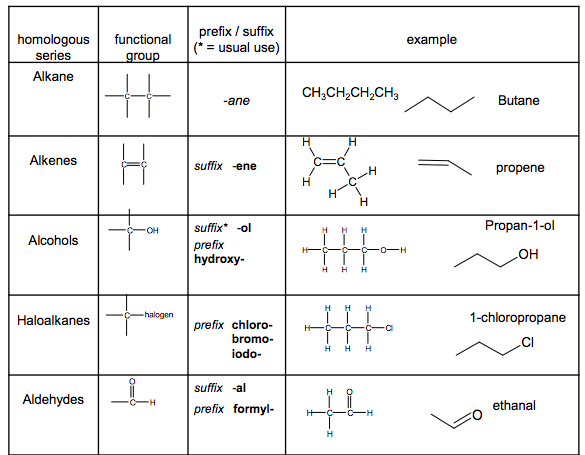
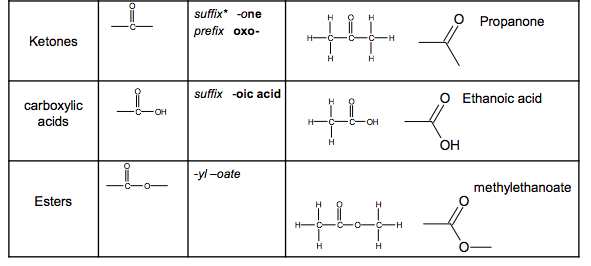

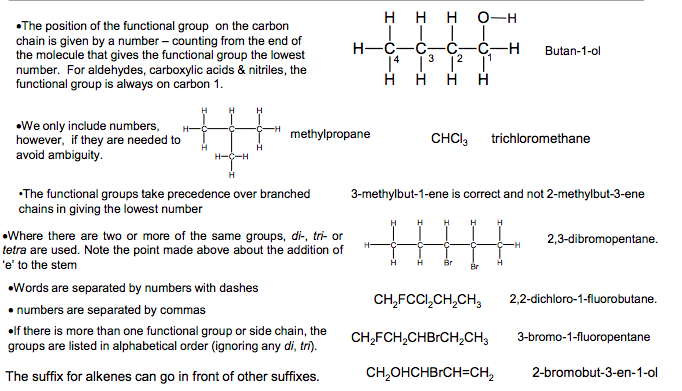


homologous series functional group prefix / suffix (* = usual use) example Alkane -ane CH3CH2CH2CH3 Butane Alkenes suffix -ene Alcohols suffix* -ol prefix hydroxyHaloalkanes prefix chlorobromoiodoAldehydes suffix -al prefix formylKetones suffix* -one prefix oxocarboxylic acids suffix -oic acid Esters -yl –oate C C C OH H H C H C H H C H H O H C halogen H C C H Cl H H H C H H C O H C C O H H H H C O C C O C H H H H H H C O OH C C O OH H H H C C O O H H H C H H H propene Propan-1-ol 1-chloropropane ethanal Propanone Ethanoic acid C methylethanoate O O C C C C H C H H H H H OH Cl O O OH O O O code no of carbons meth 1 eth 2 prop 3 but 4 pent 5 hex 6 hept 7 oct 8 non 9 dec 10 General rules for naming carbon chains •Count the longest carbon chain and name appropriately •Find any branched chains and count how many carbons they contain • Add the appropriate prefix for each branch chain Eg -CH3 methyl or -C2H5 ethyl –C3H7 propyl 3,5-dimethylheptane Basic rules for naming functional groups N Goalby chemrevise.org 3 H3C CH CH2 CH2 CH3 CH CH2 CH3 CH3 1 2 3 4 5 6 7 •The position of the functional group on the carbon chain is given by a number – counting from the end of the molecule that gives the functional group the lowest number. For aldehydes, carboxylic acids & nitriles, the functional group is always on carbon 1. Butan-1-ol •We only include numbers, however, if they are needed to avoid ambiguity. H C C C H H H H H H C H H H methylpropane •Words are separated by numbers with dashes • numbers are separated by commas •If there is more than one functional group or side chain, the groups are listed in alphabetical order (ignoring any di, tri). The suffix for alkenes can go in front of other suffixes. •When using a suffix, add in the following way : If the suffix starts with a vowel- remove the –e from the stem alkane name e.g. Propan-1-ol, butan-1-amine, ethanoic acid, ethanoylchloride, butanamide If the suffix starts with a consonant or there are two or more of a functional group meaning di, or tri needs to be used then do not remove the the –e from the stem alkane name e.g. Propanenitrile, ethane-1,2-diol, propanedioic acid, propane-1,2,3-triol, Pentane-2,4-dione. •The functional groups take precedence over branched chains in giving the lowest number 3-methylbut-1-ene is correct and not 2-methylbut-3-ene CH2FCH2CHBrCH2CH3 3-bromo-1-fluoropentane CH2FCCl2CH2CH3 2,2-dichloro-1-fluorobutane. 2,3-dibromopentane. CH 2-bromobut-3-en-1-ol 2OHCHBrCH=CH2 C C C C C Br H H H H H Br H H H H H CHCl3 trichloromethane •Where there are two or more of the same groups, di-, tri- or tetra are used. Note the point made above about the addition of ‘e’ to the stem H C C C C H H H H H H H O H H 4 3 2 1 Haloalkanes Class the halogen as a substituent on the C chain and use the suffix -fluoro, -chloro, -bromo, or –iodo. (Give the position number if necessary) 2-bromobutane Alcohols These have the ending -ol and if necessary the position number for the OH group is added between the name stem and the –ol If the compound has an –OH group in addition to other functional groups that need a suffix ending then the OH can be named with the prefix hydroxyCH3 CH CH2 CH3 OH 1 2 3 4 Butan-2-ol H3C CH C O OH OH 2-hydroxypropanoic acid OH CH2CH2 OH H2C CH H2C OH OH OH If there are two or more -OH groups then di, tri are used. Add the ‘e’ on to the stem name though Ethane-1,2-diol propane-1,2,3-triol 4 N Goalby chemrevise.org H C C C C H H H H H Br H H H C O C H H H H Aldehydes An aldehyde’s name ends in –al It always has the C=O bond on the first carbon of the chain so it does not need an extra number. It is by default number one on the chain Ethanal C C C O H H H H H H Propanone Ketones Ketones end in -one When ketones have 5C’s or more in a chain then it needs a number to show the position of the double bond. E.g. pentan-2-one Carboxylic acids These have the ending – oic acid but no number is necessary for the acid group as it must always be at the end of the chain. The numbering always starts from the carboxylic acid end C C O O H H C H H H H Ethanoic acid If there are carboxylic acid groups on both ends of the chain then it is called a – dioic acid C C O OH O OH Ethanedioic acid Note the e in this name C C C O H H H H C H C H O H H Pentane-2,4-dione If two ketone groups then di is put before –one and an an e is added to the stem Esters Esters have two parts to their names C C C O O C H H H H H H H H The bit ending in –yl comes from the alcohol that has formed it and is next to the single bonded oxygen. The bit ending in –anoate comes from the carboxylic acid. (This is the chain including the C=O bond) methylpropanoate
4.1.1 Basic concepts of organic chemistry
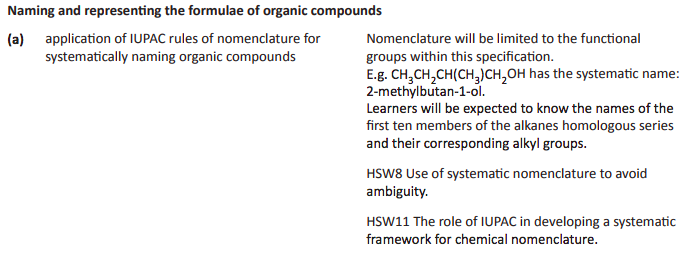
Naming and representing the formulae of organic compounds (a) application of IUPAC rules of nomenclature for systematically naming organic compounds Nomenclature will be limited to the functional groups within this specification. E.g. CH3CH2CH(CH3)CH2OH has the systematic name: 2-methylbutan-1-ol. Learners will be expected to know the names of the first ten members of the alkanes homologous series and their corresponding alkyl groups. HSW8 Use of systematic nomenclature to avoid ambiguity. HSW11 The role of IUPAC in developing a systematic framework for chemical nomenclature.
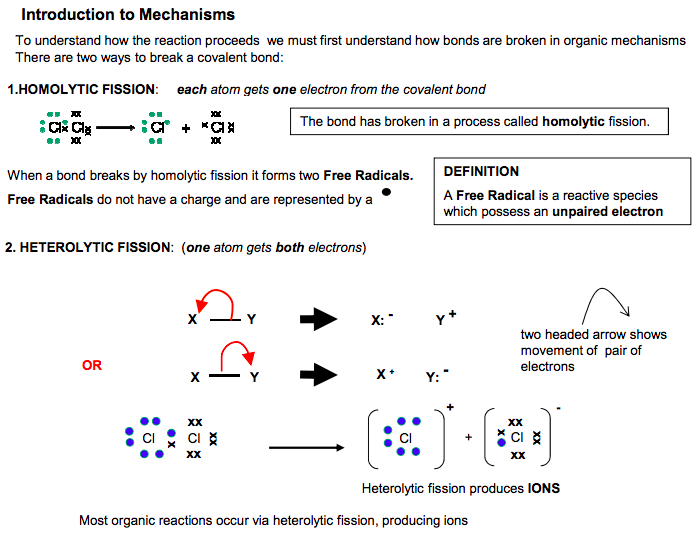
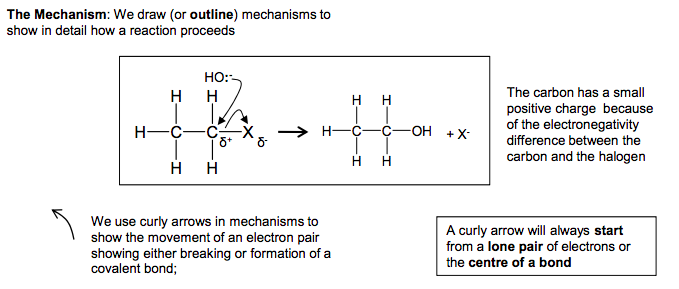
Introduction to Mechanisms The bond has broken in a process called homolytic fission. each atom gets one electron from the covalent bond When a bond breaks by homolytic fission it forms two Free Radicals. Free Radicals do not have a charge and are represented by a DEFINITION A Free Radical is a reactive species which possess an unpaired electron The carbon has a small positive charge because of the electronegativity difference between the carbon and the halogen The Mechanism: We draw (or outline) mechanisms to show in detail how a reaction proceeds We use curly arrows in mechanisms to show the movement of an electron pair showing either breaking or formation of a covalent bond; A curly arrow will always start from a lone pair of electrons or the centre of a bond H C C + XH H H H X HO: – δ + δ – X Y X Y Y + X: – Y: – X + 2. HETEROLYTIC FISSION: (one atom gets both electrons) OR Heterolytic fission produces IONS Cl Cl xx xx xx x x Cl Cl xx xx xx + + – two headed arrow shows movement of pair of electrons To understand how the reaction proceeds we must first understand how bonds are broken in organic mechanisms There are two ways to break a covalent bond: Most organic reactions occur via heterolytic fission, producing ions
4.1.1 Basic concepts of organic chemistry

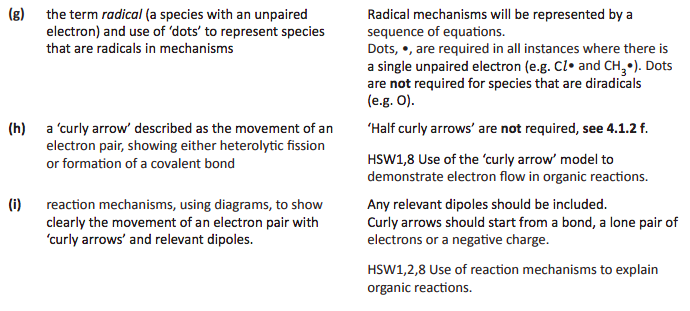
Reaction mechanisms
(f) the different types of covalent bond fission:
(i) homolytic fission (in terms of each bonding atom receiving one electron from the bonded pair, forming two radicals)
(ii) heterolytic fission (in terms of one bonding atom receiving both electrons from the bonded pair)
(g) the term radical (a species with an unpaired electron) and use of ‘dots’ to represent species that are radicals in mechanisms Radical mechanisms will be represented by a sequence of equations. Dots, •, are required in all instances where there is a single unpaired electron (e.g. Cl• and CH3•). Dots are not required for species that are diradicals (e.g. O). (h) a ‘curly arrow’ described as the movement of an electron pair, showing either heterolytic fission or formation of a covalent bond ‘Half curly arrows’ are not required, see 4.1.2 f. HSW1,8 Use of the ‘curly arrow’ model to demonstrate electron flow in organic reactions. (i) reaction mechanisms, using diagrams, to show clearly the movement of an electron pair with ‘curly arrows’ and relevant dipoles. Any relevant dipoles should be included. Curly arrows should start from a bond, a lone pair of electrons or a negative charge. HSW1,2,8 Use of reaction mechanisms to explain organic reactions.
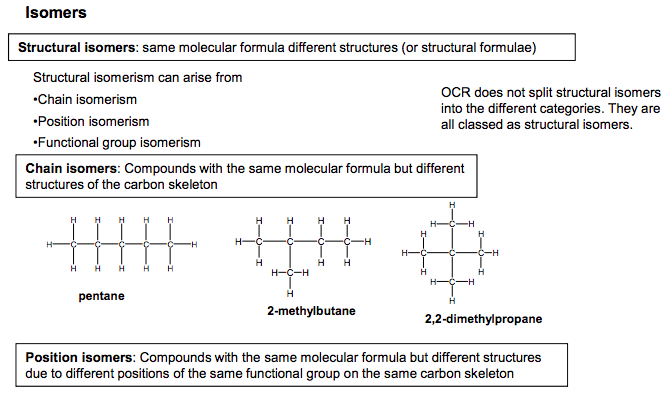
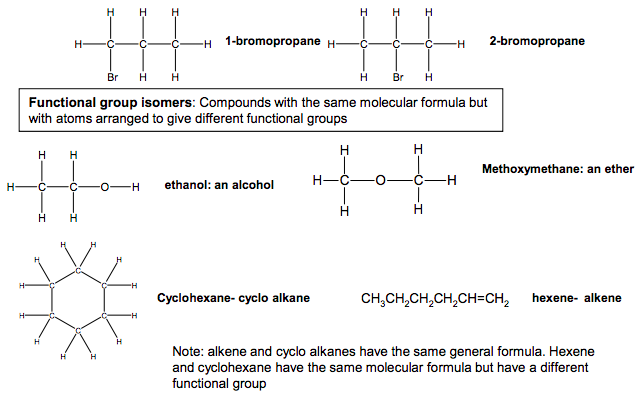
Structural isomers: same molecular formula different structures (or structural formulae) Functional group isomers: Compounds with the same molecular formula but with atoms arranged to give different functional groups Chain isomers: Compounds with the same molecular formula but different structures of the carbon skeleton Isomers Structural isomerism can arise from •Chain isomerism •Position isomerism •Functional group isomerism C C C H H H H H C C H H H H H H H H C C C H H H H H H C C H H H H H H C C C H H H H H C H H C H H H H pentane 2,2-dimethylpropane 2-methylbutane Position isomers: Compounds with the same molecular formula but different structures due to different positions of the same functional group on the same carbon skeleton C C H H Br H C H H H H C C H H H Br C H H H H 1-bromopropane 2-bromopropane C O C H H H H H H C O H H H C H H H ethanol: an alcohol Methoxymethane: an ether C C C C C C H H H H H H H H H H H H Cyclohexane- cyclo alkane CH3CH2CH2CH2CH=CH2 hexene- alkene Note: alkene and cyclo alkanes have the same general formula. Hexene and cyclohexane have the same molecular formula but have a different functional group N Goalby chemrevise.org 5 OCR does not split structural isomers into the different categories. They are all classed as structural isomers.
4.1.1 Basic concepts of organic chemistry
Isomerism
(e) explanation of the term structural isomers (compounds with the same molecular formula but different structural formulae) and determination of possible structural formulae of an organic molecule, given its molecular formula



















